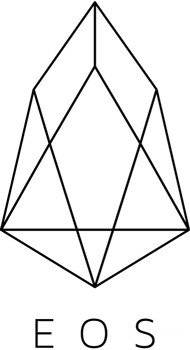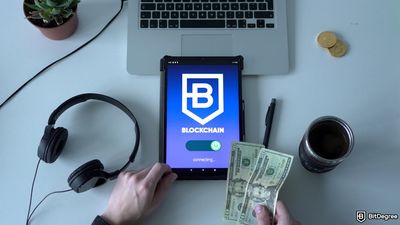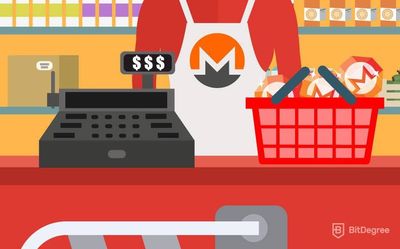With the increased popularity of crowdfunding, Initial Coin Offering's became the next big step in gathering the funds and the capital needed to start a business. 2017 was the year that ICO's have exploded in popularity and this might be due to cryptocurrencies and blockchain dominating the media or merely providing contributors an easy way to support a project.

Did you know?
Want to get smarter & wealthier with crypto?
Subscribe - We publish new crypto explainer videos every week!
What is a MetaMask Wallet? (And How to Use it - Animated)


Table of Contents
- 1. Technology that makes ICOs possible
- 2. Tokens and Smart Contracts
- 3. Mastercoin, the first ICO
- 4. The most successful ICOs of all time
- 5. The differences between Ethereum and EOS
- 6. The differences between Ethereum and NEO
- 7. Token vs coin: what's the difference?
- 8. Create your own cryptocurrency
- 9. Google, Facebook, Mailchimp Initial Coin Offering ban
- 10. Conclusion
Technology that makes ICOs possible
ICOs take advantage of the blockchain technology. Blockchain is unique in that all of the blocks of data are linked together to form a public database. The database is considered public because it is shared with hundreds or even thousands of computers. Think of these computers as servers for the blockchain or the database.
Latest Deal Active Right Now:
$600 WELCOME BONUS
Binance Black Friday Deal
If you're new to Binance, great news - this Binance Black Friday period, you can earn up to $600 in rewards. Sign up, use the code 49316610, and start earning now!
Any changes made to the public database need to be verified by more than 51% of the computers on the network. If they are not confirmed, the change cannot be made. This technology used by Initial Coin Offering makes it extremely hard to hack the database because the hacker would have to take control of 51% of the computers at the same time. A variety of companies and institutions owns these computers.
Moreover, the fact that a single institution does not control all of the nodes is called decentralization. That means that blockchain is just a more secure database that isn't owned by a unique entity, and everyone can make changes as long as 51% of owners agree that the change is valid.
The database changes in question refer to various transactions being made. In the case of Bitcoin, these transactions are people selling or buying bitcoins, and the database keeps track of how much bitcoin each person has. However, blockchain can keep track of much more than just transactional data. Virtually it could be absolutely anything, as long as there's something that represents the value of an object or service.
For example, the transactional value could represent a car or an electrical bill. Of course, there is no way to place these values onto a blockchain physically. Instead, something that represents the value of those things is needed. One of such value representative tools could be a token.
Tokens and Smart Contracts
Tokens are created to represent the value of something. These tokens cannot be applied directly to the blockchain, as blockchains can typically only process transactions of their own cryptocurrency — like Ether on the Ethereum blockchain and Bitcoin on the Bitcoin blockchain.
 Token transactions must be processed by using an application. The applications that tokens use are called smart contracts. In 1994, Nick Szabo (a cryptographer), had a vision. He wanted to create contracts using computer code. This contract would be activated automatically when certain conditions are met. Furthermore, there would be no way to cheat these conditions, because all of them would be stated in computer code.
Token transactions must be processed by using an application. The applications that tokens use are called smart contracts. In 1994, Nick Szabo (a cryptographer), had a vision. He wanted to create contracts using computer code. This contract would be activated automatically when certain conditions are met. Furthermore, there would be no way to cheat these conditions, because all of them would be stated in computer code.
Because a trusted third-party is no longer needed while making contracts, these contracts (or transactions) can automatically execute themselves on a trusted network. Computers completely control this network. The essential characteristics of a smart-contract:
- They can automatically process transactions
- The transactions are triggered only when the right conditions are met. Imagine it like this: “WHEN Peter pays 100 Ether into the smart contract, THEN John’s house token is sent to Peter.”
- Smart contracts use blockchain technology, so the conditions of the smart contract cannot be changed.
ICOs are already taking advantage of smart-contracts and the blockchain technology to crowdfund projects. A smart contract and a token for that smart contract is needed when creating an ICO. The next step is stating the smart contract conditions. For example: IF 0.1 ETH is sent to the smart contract, THEN the smart contract will send 1 Token to the address that sends the 0.1 ETH.
This ensures that everyone who participates in Initial Coin Offering will always get the correct amount of tokens. No human interaction, or manual distribution. The smart-contracts are usually publicly available as well, so all participants can review the terms of the smart-contract.
The two most common reasons people participate in ICOs are as follows:
- The token can be used on the application once the final product is ready.
- As the popularity of the project grows, the price of the tokens or coins could increase. As more people will want to use the services, demand goes up.
Mastercoin, the first ICO
Think of ICOs as a blockchain version of Kickstarter. The critical difference is that it automates the whole crowd sale process in a secure, trustless way. However, it all started with the first ICO held by Mastercoin back in July 2013.
Mastercoin made their white-paper public in January 2012, they have proposed that the existing Bitcoin network could be used as a protocol layer for higher-level protocols. The goal was to enable new rules for contracts. This would allow people to create new currencies without the need for a separate blockchain.
This is similar to what Ethereum is doing right now, Ethereum is even being referred to as Mastercoin 2.0. Also, though the white-paper was public since January 2012, the fundraising to make this project a reality started on July 31st, 2013. When J. R. Willett, the man credited with inventing the Initial Coin Offering, began what became the first ICO ever.
August 15th was the date that the first ever Mastercoin transaction was recorded. The network was put to the test with 1 test Mastercoin being sent. After the testing, Mastercoin was open to the public and has continued to receive a steady flow of funding. However, the most significant wave of investors was exposed to Mastercoin during a presentation to BitAngels. BitAngels were the first investor network and incubator created to invest exclusively in cryptocurrency startups. BitAngels were interested in Mastercoin and were onboard with the project.
During the fundraising Mastercoin set-up a Bitcoin address, if someone sent BTC to the address before the 31st of August, they would get 100x the amount of Mastercoins. So, if someone sent 0.01 BTC to the address, he or she would get 1 Mastercoin back. At the end of the Mastercoin ICO, they have raised around 4700 BTC, which was valued at roughly 500 thousand USD at the time. For comparison 4700 BTC is valued at around 41 million USD at the time of writing this. At its all-time high Mastercoin traded at 0.25 BTC to 1 MSC.

However, in 2015, Mastercoin has changed its name to Omni and started rebranding. Their goal was to leave all of the bad press, critiques, and community outrage that Mastercoin got and start fresh. As a result of the rebranding, a lot of the remaining Mastercoin leaders, including chief architect JR Willet, CTO Craig Sellars, and board member and BitAngels co-founder David Johnston, have migrated to Omni.
Sadly, the project has lost much traction and left people unsatisfied. Mastercoin or Omni is only valued 0.0041 BTC to 1 OMNI coin today. However, this has not stopped people from contributing to the Initial Coin Offering model.
This method of fundraising proved to be an effective way to crowdfund a project. Instead of turning to private investors that would contribute large sums of money Mastercoin managed to successfully reach its funding goal by collecting funds from over 500 smaller investors from all around the world.
The most successful ICOs of all time
Up until 2017, companies that raised over several million dollars during their ICOs were quite rare. Ethereum, the second largest cryptocurrency in 2018, has raised $18 million in 2015 due to its innovative smart contracts. The next significant milestone for ICOs happened in 2016. DAO has raised 150 million dollars in a matter of minutes. DAO later experienced security issues that led to a hack and a loss of over 50 million dollars.
Since the days of Mastercoin, Ethereum and other early ICOs, the concept has gained a lot more traction. Initial Coin Offerings have collectively raised nearly 10 billion dollars in 2017 and 2018 combined. The cryptocurrency market seemed to slow down at the end of 2017. With December being the most active month in 2017 raising over 1 billion million dollars. However, 2018 has been a great start to ICOs with March being the most active month yet. During March 2018 over 2,9 billion dollars were raised across various Initial Coin Offerings.
 In August 2017 the Filecoin ICO raised 257 million dollars from over 2,100 investors, making Filecoin the biggest ICO in 2017. Filecoin will allow its users to rent out the free space on their hard drives. Users would then get Filecoin, which they could exchange for USD, ETH, BTC, and other currencies. The success of Filecoin and other ICOs show that the ICO model is a great way to kickstart a business.
In August 2017 the Filecoin ICO raised 257 million dollars from over 2,100 investors, making Filecoin the biggest ICO in 2017. Filecoin will allow its users to rent out the free space on their hard drives. Users would then get Filecoin, which they could exchange for USD, ETH, BTC, and other currencies. The success of Filecoin and other ICOs show that the ICO model is a great way to kickstart a business.
Top 10 ICOs of all time:
| Position | Project name and ticker | Total amount raised in dollars |
| 1 | EOS (EOS) | 4.2 billion |
| 2 | Telegram (GRAM) | 1.7 billion |
| 3 | Dragon Coin (DRG) | 320 million |
| 4 | Houbi Token (HT) | 300 million |
| 5 | Filecoin Futures (FIL) | 257 million |
| 6 | Tezos (XZT) | 232 million |
| 7 | Sirin Labs Token (SRN) | 158 million |
| 8 | Bancor (BNT) | 153 million |
| 9 | Bankera (BNK) | 152 million |
| 10 | Polkadot (DOt) | 151 million |
1. EOS (EOS) had raised an incredible 7,162,546.39 ETH going into their final day, meaning they have so far raised $4,201,836,214 ($4.2 billion) at the current Ethereum price of $586 according to BitGuru. The EOS ICO lasted for 350 days in total and was finished on the 1st of July.
2. Telegram (GRAM) is often referred to as the number 2 ICO of all time by raising 1,7 billion dollars. However, it could be argued that Telegram doesn't fall into the same category as other ICOs as they didn't have an ICO and their cryptocurrency was never offered to the public. The way Telegram raised 1,7 billion dollars was by having 2 private pre ICO sales according to Theverge. Attracting 81 investors that collectively contributed 850million dollars and later having a second private sale that attracted 94 investors that contributed another 850million dollars. Since Telegram only had 2 pre-ICO sales, they never needed to crowdsource, and their ICO was funded before it ever began.
3. Dragon Coin (DRG) has raised 320million dollars according to Brazzi. Dragon is a decentralized currency that's used for gambling. The Dragon Coin (DRG) is set to function within Casinos and enhance the age-old gaming industry.
4. Huobi token (HT) raising 300million dollars. Houbi tokens act as a blockchain powered loyalty point system. The tokens allow users to get discounts on the Houbi exchange and trade against other popular cryptocurrencies like ETH or BTC pairs.
5. Filecoin Futures (FIL) has raised 257million. Filecoin stands out because the ICO complies with the new SEC regulations on ICOs. Meaning, only contributors with accreditation were able to participate in the ICO. Failing to comply with SEC laws or performing a KYC might result in a coin or token gathering a lot of funds, but no banks would accept them, meaning the exchange from ETH to FIAT often is impossible. Filecoin has taken all measures to prevent this from happening.
6. Tezos (XTZ) has raised 232 million dollars. Tezos is developing a self-amending distributed ledger that will be used to create smart-contracts. Tezos allows their token-holders to approve and fund new protocol updates. This will enable Tezos to mitigate any scaling or development disputes in the future of the Tezos network.
7. Sirin Labs Token (SRN) has raised 158 million dollars. Sirin is aiming for the mass adoption of blockchain technology. They're focusing on developing secure hardware, the monetization of additional device resources via microtransactions. At the moment Sirin is creating an ecosystem around blockchain.
8. Bancor (BNT) raised 153million dollars. Bancor is a protocol that allows people to issue their cryptocurrency. They call the cryptocurrency smart tokens. The primal benefit of using smart tokens is that they do not need a secondary party if you want to exchange them. Bancor employs Smart Tokens and converts them between different ERC-20 tokens internally.
9. Bankera (BNK) raised 152million dollars. Bankera is focusing on building a bank that can work during the blockchain era. To provide utility to the Bankera tokens, they're not charging any fees for trading BNK tokens against any pair. This was done to keep users buying BNK tokens first, then trading them for other cryptocurrencies without fees.
10. Polkadot (DOT) raised 151million dollars. Polkadot is looking to create a scalable heterogeneous multi-chain. And unlike previous blockchain implementations which mostly focused on a single chain, Polkadot doesn't have any inherent functionality at all. Polkadot provides the bedrock "relay-chain" that can host other validatable and dynamic data-structures.
The differences between Ethereum and EOS
Projects like DAO or Filecoin have used the Ethereum network to organize their ICOs. However, there are Ethereum alternatives out there. One of these alternatives is EOS.

EOS is amongst one of the newest blockchain projects that entered the cryptocurrency market. The goal of EOS is to build a robust network that is capable of processing millions of transactions per second. However, EOS has not finished building their product yet. At this stage, everything is just theoretical. The most exciting part about EOS is that they want to build a platform that functions as an operating system. Hence, the name E-OS. The ability to process millions of transactions per second would solve a big problem, as other blockchains can recognize smart contracts, none of them can perform this task quickly enough. For example, even though Ethereum is the most popular smart contract blockchain, it can only handle 15 transactions per second.
EOS ICO (like many other smart contract blockchains) is often referred to as the “Ethereum Killer” because it can do everything that Ethereum can, just faster. Being able to process data faster helps EOS with the “Scalability” issue that Ethereum is currently facing. Scalability is one of the most important things to consider when analyzing the potential of a blockchain project.
Since Ethereum is still only able to process about 15 transactions every second, it runs into issues when more operations need to be handled. The more transactions are queued up, the completion time for each transaction increases. Although the EOS network has not been built yet, the EOS ICO (Initial Coin Offering) has been very interesting for a couple of reasons.
INTERESTING FACT
The Initial Coin Offering that EOS is organizing to fund their project has started on June 26th, 2017. The end date for this is set for June 1st, 2018. This makes the EOS Initial Coin Offering a total of 350 days long, currently the longest-running ICO ever.

During the 350-day ICO EOS has managed to raise 7,162,546.39 ETH going into their final day. This means that they have so far raised $4,201,836,214 ($4.2 billion) at the current Ethereum price of $586.
The amount of funds raised by EOS makes them not only the longest-running Initial Coin Offering but one of the most successful ICO’s of all time. Once the EOS ICO has finished, they have released 700 million of their tokens, which is equal to 70% of the total token supply. EOS has some experienced team members, including Daniel Larimer, who was also a co-founder at both BitShares and Steem. Larimer’s cryptocurrency projects are now worth billions of dollars.
Using the Initial Coin Offering model, the business allows world-wide participation, and the ease of involvement makes sure that people that might not consider investing before can do so. Fundraising through the Initial Coin Offering model shows that given the proper conditions, the investor market is a lot bigger than previously thought of by companies looking to get financed.
The main attraction of Initial Coin Offering (ICO) is that investors can see the results of their investments in real time. Since they are trading one currency for another, and all of the data is public. As an investor, they can track the price of their investment, and make decisions based on public opinion or the progress of the team.
The differences between Ethereum and NEO
Another cryptocurrency that has been contending for the #1 spot is NEO. NEO has been proliferating and making a good attempt at catching up with Ethereum. However, as EOS is working on increasing the number of transactions processed, NEO is doing much more. Core differences between NEO and Ethereum could be summarized into:
- NEO has found instant support among the developer community because it supports programming in multiple languages like C++, C#, Java. On the other hand, to create a project on the Ethereum network, a relatively new language explicitly created for smart contract development called Solidity needs to be used.
- Transaction speed. NEO can handle about 10,000 transactions per second as Ethereum is limited to 15 transactions per second.
- The NEO blockchain has two different coins — NEO and GAS. Ethereum only has Ether. Anyone who holds NEO in their wallet gets rewarded in the form of GAS. You can think of NEO as the stocks of a company and GAS as the dividend.
- Ethereum (Ether) is divisible into smaller units (gas), but NEO is indivisible. So, transfers of 10.5 NEO or 1.2 NEO are impossible, as it only exists in whole numbers.
- NEO is the first and most significant Chinese cryptocurrency and is allegedly supported by the Chinese government. Ethereum, on the other hand, isn’t supported by the Chinese government. NEO has an excellent opportunity of capturing the massive Chinese market and other Asian markets.
Token vs coin: what's the difference?
Talking about NEO, Ethereum and EOS it is essential to mention the difference in token vs coin. Best way to distinguish coins and tokens by analyzing the cryptocurrency itself. Coins are native to their blockchain, like Bitcoin. Tokens have been built on top of another blockchain. So, Ether would be a coin, because it has a native blockchain.
However, if the Ethereum network is utilized and a new cryptocurrency is created on top of the Ethereum network, it is considered a token. So, in short, the difference in token vs coin is having a blockchain.
Create your own cryptocurrency
When you want to create your own cryptocurrency, it is essential to decide if a separate blockchain is needed. Because this decision drastically changes the creation process. If you want to create your own cryptocurrency, with a separate blockchain requires more funding and time. However, if a separate blockchain is not needed, a token can be created instead. This way, rather than building a separate blockchain, an app is built. This app runs on an existing blockchain — like Ethereum or NEO. Main things that needed to be considered before creating a cryptocurrency should be:
- The idea, what problem does the project solve and how is it different than existing solutions?
- Developers, if an ERC20 token is being made ( on the Ethereum network), developers who are proficient in Solidity will be needed. If a NEP-5 token is being made, Developers that proficient in such programming languages as C++ and Java will be needed. Furthermore, the developers will also need to create a smart-contract if an ICO will be organized to crowdfund.
- A code audit performed by professionals. If security issues appear mid-through the project, it could be the end of it. An examination decreases the chances of projects getting hacked.
- An informative summary of the project. Having an informative white-paper, roadmap or pitch-deck allows potential contributors to get better acquainted with the project.
White papers should be easy to read, concise and go over all of the major points of the project. A white paper is where potential contributors could get all of the required information about your project. When a potential contributor reads through the white paper, they should not have any questions left to ask. The best white papers are also original, easy to read and understand, outlines all of the significant points in sequence. Some of the best white papers also contain graphs/charts/illustrators that help contributors get a better understanding of what problem and how the project is solving it.
A white paper should generally be formatted as a PDF. This ensures that the white paper is easy to distribute. However, it is hard to edit. White paper edits are frowned upon in the cryptocurrency community as people feel that the team did not pay enough attention while outlining their mission or want to change the product they have set out to make.
Avoid fluff and redundancy. Longer white papers are not considered better in any way. As potential investors spend time and energy reading through the white paper, it is best to keep it relevant. Explaining all of the significant points in as few pages as possible.
Taking advantage of Initial Coin Offerings worldwide appeal, the white paper should reflect this. Translating the white paper into multiple languages can significantly increase the reach of the project and help investors from non-English speaking countries better understand the plan.
Perfecting your white paper is no easy task. However, a genuine team should not run into any problems assembling the information they need to construct a great white paper. White papers help finalize the vision and work out all of the details ahead of time.
Google, Facebook, Mailchimp Initial Coin Offering ban
ICOs have come a long way since their inception during the summer of 2013. Raising such large amounts of money that is very hard to trace or recover, because most transactions are anonymous didn't come without their downfalls. Google, Facebook, Mailchimp have already banned Initial Coin Offering advertisements.

The ban has happened after fraudulent ICOs crowdsourced their projects and simply ran away with all of the money. These fraudulent ICOs are the reason that extra effort has been put into protecting less informed users. The advertisement ban also directly impacts various Initial Coin Offering marketing efforts. Making way for new platforms to increase in popularity for advertisements.
Like LinkedIn, paid ads are still banned, but cryptocurrency communities still exist. Engaging with these communities could open up like-minded cryptocurrency/blockchain enthusiasts into backing your project. Other channels like Telegram, which allows users to create groups with up to 100 thousand members and offer instant messaging have been significant in the cryptocurrency community.
Moreover, actively participating in Reddit discussions can provide a project to one of the biggest audiences in the world. In conclusion, the social media ban has affected the cryptocurrency market in one way or another. However, Facebook or Twitter are not the places where most of the cryptocurrency enthusiasts hang-out, these were more used to target new customers.
Conclusion
In the end, everyone who decides to participate in an Initial Coin Offering should do their research and practice caution. Cryptocurrency is not a niche for the selected few anymore. It is a multi-billion industry where investors can make or lose significant amounts of money in a couple of weeks. There is much potential in utilizing the blockchain technology for future projects.
Organizing an Initial Coin Offering might be the easiest way to get funded. However, nothing is without its dangers. Organizing a successful Initial Coin Offering needs a well thought out project, an experienced and dedicated team to create successful marketing campaigns and public support. Want to read more about what is ICO? Follow one more article on our blog.
The content published on this website is not aimed to give any kind of financial, investment, trading, or any other form of advice. BitDegree.org does not endorse or suggest you to buy, sell or hold any kind of cryptocurrency. Before making financial investment decisions, do consult your financial advisor.













